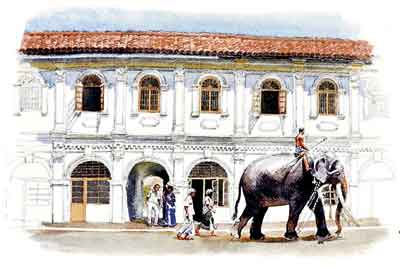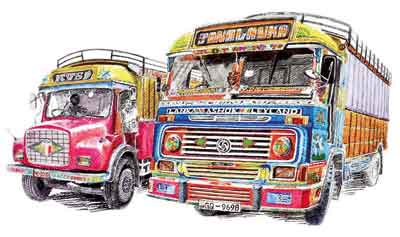Seeing something to paint all the way

A Dutch period building in Galle: Sedgley bought his bottles of water from the ‘little shop tacked on to the front’
Robert Sedgley has seen more of Sri Lanka than most Sri Lankans, tramped through forests, trekked to countless religious and historical sites and walked the dusty city streets and alleys, his keen artist eye noting the everyday scenes that we, seldom stop to observe.
The British artist is familiar to art lovers in this country; he has been visiting since 1998 and has held regular exhibitions. His latest, which runs from February 19, (from 6.p.m.) to Wednesday, February 21, at the Lionel Wendt Gallery features images from his book ‘Travels with a paintbox’ which was launched just last month at the Fairway Galle Literary Festival. The nearly 200 new works on display, watercolours and pencil sketches give some indication of his prodigious output.
“Robert Sedgley’s skills as a watercolourist and a topographical draughtsman with an eye for significant detail, capturing so many interesting anecdotal touches, makes this portfolio a memorable visual diary of the Sri Lankan experience,” wrote the late Prof. Ashley Halpe in the foreword to ‘Travels with a paintbox’.
The idea for the book, came from Dominic Sansoni when he was having his second exhibition at the Barefoot Gallery many years ago and Sedgley took it to heart. Well-known academic and historian, Dr. K.D. Paranavitana stepped in with the text which gives the background to the cities – Colombo, Kandy, Galle, the historic sites, buildings of old, while Juliet Coombe of Serendipity Publishing undertook the publishing.

Sedgley’s personal favourite : The Asokaramaya monastery
It falls within two stones, says Sedgley of the book. “It’s not really a travel guide- it’s not really an autobiography. It’s pictures of my travels, my thoughts, some quite strange, odd things that I see.” It is presented too as an artist’s sketchbook, with the notes written in his hand, offering some insight into his thinking. “A fine avenue of Cook’s Pines runs alongside the river. Some people call them ‘drunken’ on account of their sinuous interleaving ‘s’ shaped trunks but I prefer to call them ‘dancing trees’,” he writes of the famous avenue at Peradeniya Gardens. Describing a clock tower in Jaffna, a city he has visited twice, his note reads, “Built by the British, the rather incongruous clock tower has four clocks donated by Prince Charles; each, with a refreshing air of independence keeping a different time.”
That he is drawn to architectural composition is clear, though he states emphatically that he doesn’t paint ‘romantic ruins’. What draws him is the form and colour, he sees in the buildings both old and new, where he says he looks for a combination of shapes and colours, unified by the light and underlying grid structure of architecture.

Robert Sedgley
For Sedgley, art has been his life. As a youngster he went to Junior Art School in Birmingham, where he discovered a fascination for lettering which would later influence his sense of design and space. Initially working as a silk-screen painter and poster writer, he studied at the Birmingham and Exeter Colleges of Art, taking evening classes in life drawing, portraiture and sculpture, before opting to become an art teacher. His wife Jean, who has accompanied him on his travels is one too. In later years, they moved to a little village in Spain which brought a new dimension to his art-a lightening and brightening of his palette. It was on the invitation of a friend living there, Jill, a volunteer nurse that they first visited Sri Lanka in 1998 and what has brought him back so regularly since then, has been the enduring friendships he formed here. The book is dedicated to Ashley Halpe and Lesley Dunuwille – it was at the Dunuwille couple’s guesthouse overlooking the Kandy lake that Sedgley and Jean stayed on their first visit and now “that guest house is like our second home in the world,” he says.

Lawyers’ offices in Kandy
On that same trip having seen a poster advertising S.H. Sarath’s exhibition at the Lionel Wendt in Colombo, they decided to drop in and so began another firm friendship as the two artists met. “Now he’s my greatest friend,” Sedgley says as Sarath who has come along to this interview beams in agreement. It was he who invited Sedgley back to Sri Lanka, hosting his first exhibition at his own gallery.
Other meetings in unlikely places have been equally serendipitous – Sedgley recalls how they got talking to another English couple at a restaurant in Spain when he was celebrating his birthday some years ago and it turned out, the lady too was celebrating her birthday. She had studied art and design; a couple of meetings later, Sedgley had his book designer – Chris de la Nougerede.
‘Travels with a paintbox’ while covering the country’s famed attractions, Anuradhapura, Dambulla, Polonnaruwa, Kandy reveals many places less touristy and one of Sedgley’s personal favourites is the Asokaramaya monastery. “The Buddha, serene and commanding, seated with raised hand has presided in this silent forest domain for a thousand years’ he notes in the book. His sketches also capture a vanishing Lanka beseiged by invading commercialization, Galle being a case in point, much changed since his first visit 20 years ago. A particularly lovely sketch in his book is of a Dutch period house in Hospital Street with a verandah and inner courtyard where French writer Nicholas Bouvier had lived in the ’50s writing a novel about the island in a sparsely furnished room upstairs. He was vastly relieved to find it almost unchanged..

Painted buses in Pettah
Back home in Villalonga, the little Spanish village which is home, Sedgley has been working on a large canvas of the goddess Kali- a product of his interest in Eastern religions and Hindu mythology, prompted after reading William Dalrymple’s book on “The Age of Kali’. The goddess of destruction is seen leaping through a blackened landscape with guns blazing, the world blowing up in her hands, stealth bombers coming out of her eyes, religious symbols disintegrating. There are influences of artists like Hieronymus Bosch and Bruegel too, he says, of the work that has been taking shape these past three years. Meanwhile he finds time to teach art history too through a programme where older people come together to share their knowledge and skills: It keeps us young, he smiles.
His Colombo exhibition will bring viewers new vistas in the familiar. “A painting needs time to tell its story,” he reminds us. “Paintings in a gallery should be islands of tranquillity; they need a quiet mind to allow them to reveal their secrets. I spend many hours with these pictures, allowing them to grow into their maturity – so my hope is that the spectator will spend at least a few minutes with each one.”
-Renuka Sadanandan


